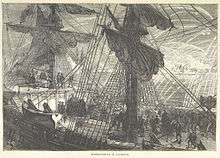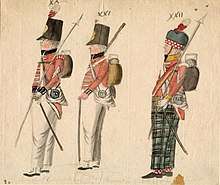Walcheren Campaign
The Walcheren Campaign was an unsuccessful British expedition to the Netherlands in 1809 intended to open another front in the Austrian Empire's struggle with France during the War of the Fifth Coalition.[1] Around 40,000 soldiers, 15,000 horses together with field artillery and two siege trains crossed the North Sea and landed at Walcheren on 30 July. This was the largest British expedition of that year, larger than the army serving in the Peninsular War in Portugal. The Walcheren Campaign involved little fighting, but heavy losses from the sickness popularly dubbed "Walcheren Fever". Although more than 4,000 British troops died during the expedition, only 106 died in combat; the survivors withdrew on 9 December.
Background
In July 1809, the British decided to seal the mouth of the Scheldt to prevent the port of Antwerp being used as a base against them.[2] The primary aim of the campaign was to destroy the French fleet thought to be in Flushing whilst providing a diversion for the hard-pressed Austrians. However, the Battle of Wagram had already occurred before the start of the campaign and the Austrians had effectively already lost the war.
John Pitt, 2nd Earl of Chatham commanded the army, whilst Sir Richard Strachan commanded the navy, the full expeditionary force of 37 ships, the greatest which had ever left England, leaving The Downs on 28 July. Commanders included Hugh Downman, Edward Codrington, Amelius Beauclerk, William Charles Fahie, George Cockburn and George Dundas.[3]
Campaign
As a first move, the British seized the swampy island of Walcheren at the mouth of river Scheldt, as well as South Beveland island, both in the present-day Netherlands. The British troops soon began to suffer from malaria; within a month of seizing the island, they had over 8,000 fever cases. The medical provisions for the expedition proved inadequate despite reports that an occupying French force had lost 80% of its numbers a few years earlier, also due to disease. Once it had been decided to garrison Walcheren Island in September 1809, Pitt was replaced by Lieutenant-general Eyre Coote who in October was replaced by Lieutenant-general George Don.[2]

At the time of the initial landings, the French forces were characterized by a divided command over a motley crew of units manned by soldiers of many nationalities spanning French-occupied Europe. There were a few French units among those present considered to be of inferior quality as they were manned by the physically infirm and dregs of the training depots.
However, on 10 August 1809, as reinforcements began flowing into the invasion zone, Napoleon approved the appointment of Marshal Jean-Baptiste Bernadotte, the Prince of Ponte Corvo, who had recently resigned his command after incurring Napoleon's displeasure at the Battle of Wagram as overall commander of the invasion zone.[4] Bernadotte had returned to Paris and was sent to defend the Netherlands by the council of ministers. His arrival gave the French a much-needed unity of command and he brought with him a genius for organization and training.[5] Bernadotte led the reinforced and reorganized French forces competently and although the British had captured Flushing on the day of his arrival to the war zone after a ferocious bombardment, and the surrounding towns on 15 August, he had already ordered the French fleet to Antwerp and heavily reinforced the city. The French numbers were such that the main objective for the British, Antwerp, was now out of reach. The expedition was called off in early September. Around 12,000 troops stayed on Walcheren, but by October only 5,500 remained fit for duty.
Aftermath
In all, the British government spent almost £8 million on the campaign. Along with the 4,000 men that had died during the campaign, almost 12,000 were still ill by February 1810 and many others remained permanently weakened. Those sent to the Peninsular War to join Wellington's army caused a permanent doubling of the sick lists there.
This campaign led to the weed known as Thanet cress being introduced to Britain in the sick men's bedding.[6]
Order of battle
British Expeditionary Force to Walcheren
- Commander-in-Chief: General Lord Chatham
- Second-in-Command: Lieutenant General Sir Eyre Coote
- Chief-of-Staff: Sir Robert Brownrigg
- Royal Artillery[7]
- Brigadier General John Macleod, Royal Artillery
- H Troop, Royal Horse Artillery[8]
- 2 brigades, 2nd Battalion, Royal Artillery
- 8 brigades, 3rd Battalion, Royal Artillery
- 2 brigades, 5th Battalion, Royal Artillery (including 1 heavy brigade)
- 4 brigades, 9th Battalion, Royal Artillery
- Brigadier General John Macleod, Royal Artillery
- 1st Division

- 2nd Division
- Lieutenant General the Marquess of Huntly
- Major General Dyott’s Brigade (1/6th; 1/50th; 1/91st)
- Brigadier General Montresor’s Brigade (1/9th; 1/38th; 1/42nd)
- Lieutenant General the Marquess of Huntly
- 3rd Division
- Lieutenant General Thomas Grosvenor
- Major General Leith’s Brigade (2/11th; 2/59th; 1/79th)
- Brigadier General Acland’s Brigade (2nd; 76th; 2/84th)
- Lieutenant General Thomas Grosvenor
- 4th Division
- Lieutenant General Alexander Mackenzie Fraser
- Brigadier General Browne’s Brigade (1/5th; 1/26th; 1/32nd; 4 coys., 2/23rd)
- Major General Picton’s Brigade (1/36th; 77th; 1/82nd; 2 coys., 2/8th)
- Lieutenant General Alexander Mackenzie Fraser
- Light Division
- Lieutenant General the Earl of Rosslyn
- Major General Stewart’s Brigade (2/43rd; 2/52nd; 8 coys., 2/95th)
- Major General von Linsingen’s Cavalry Brigade (3rd Dragoons; 9th Light Dragoons, 12th Light Dragoons; 2nd Hussars, KGL)
- Lieutenant General the Earl of Rosslyn
- Reserve
- Lieutenant General John Hope
- Brigadier General Disney’s Brigade (1/1st Foot Guards, 3/1st Foot Guards; Flank coys., 2nd Bn., Coldstream Guards & 2/3rd Foot Guards)
- Major General Erskine’s Brigade (20th, 1/92nd)
- Major General the Earl of Dalhousie’s Brigade (1/4th, 2/4th, 1/28th)
- 1 coy, 2/95th
- Lieutenant General John Hope
- Light Troops, Attached to the Left Wing of the Army
- Brigadier General Baron de Rottenberg’s Brigade (68th, 1/71st, 85th, 2 Coys., 2/95th)
- Brigadier General Mahon (9th Light Dragoons)
Naval forces
A fleet of around 40 vessels, including sixteen 74 gun warships of the third rate, participated under the overall command of Rear Admiral James Bissett. A number of smaller vessels including customs-house and excise cutters were also involved, as was a packet ship. The City of London, Loyal Greenwich, and Royal Harbour River Fencibles also contributed men to the expedition.[9]
Irish legion
The 1st battalion of the Irish Legion (raised by the French for an invasion of Ireland that never happened) was stationed in Flushing during the assault and received its baptism of fire there. It fought a rear guard action for several days but the battalion was almost completely captured. The Legion's brass band followed by the Irish battalion led the surrendered French garrison out of the town. However, a small party of Irishmen escaped and went into hiding with the battalion's cherished imperial eagle, and after a few days they crossed the Scheldt River and escaped. Commandant Lawless was presented to Napoleon and he together with Captain O'Reilly received the Légion d'honneur in gratitude.[10]
References
Citations
- Hicks, Peter. "Walcheren – The Debacle". Trafalgar Chronicle Review (20): 121–131.
- Burnham & McGuigan 2010, p. 42.
- Harrison, Cy. "Walcheren Expedition, 28th July 1809 - December 1809". Threedecks. Retrieved 7 June 2018.
- Barton, Dunbar. 1921. Bernadotte and Napoleon 1763-1810. John Murray. Pp. 226-231.
- Howard 2012, pp. 142-149.
- Bond, W.; Davies, G.; Turner, R. (October 2007), The biology and non-chemical control of Hoary Cress (Cardaria draba (L.) Desv.) (PDF), HDRA, Ryton Organic Gardens}
- Brigade here refers to half-battery
- Brown, Steve (May 2010). "British Royal Horse Artillery Companies and the Men Who Led Them – 1793 To 1815". The Napoleon Series. Retrieved 17 December 2015.
- "No. 16650". The London Gazette. 26 September 1812. pp. 1971–1972.
- Howard 2012, p. 133.
Sources
- Burnham, Bob; McGuigan, Ron (2010). The British Army Against Napoleon: Facts, Lists and Trivia, 1805-1815. Frontline Books. ISBN 978-1-84832-562-3.CS1 maint: ref=harv (link)
- Howard, Martin R. (2012). Walcheren 1809: The Scandalous Destruction of a British Army. Pen & Sword. ISBN 978-1-84884-468-1.CS1 maint: ref=harv (link)
